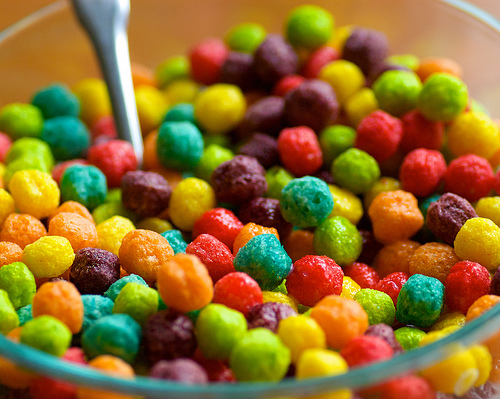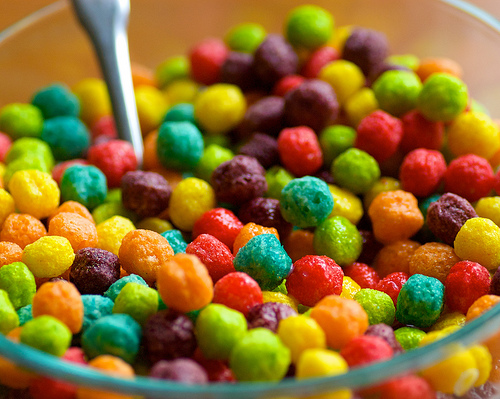Raise your hand if you serve your kids a bowl of Twinkies for breakfast. Or perhaps they prefer a few cookies instead? According to the Environmental Working Group’s (EWG) new report on children’s cereals, that’s effectively what millions of kids are eating in the morning.
Indeed, the amount of sugar in many popular brands of cereals is astonishing: Kellogg’s Honey Smacks is 56 percent sugar by weight. One cup of the stuff has more sugar than a Hostess Twinkie, says the report, while “a cup of any of 44 other children’s cereals has more sugar than three Chips Ahoy! cookies.”
EWG’s 10 worst cereals, with Honey Smacks as No. 1, include:
- Post Golden Crisp — 51.9 percent sugar
- Kellogg’s Froot Loops Marshmallow — 48.3 percent sugar
- Quaker Oats Cap’n Crunch’s OOPS! All Berries — 46.9 percent sugar
- Quaker Oats Cap’n Crunch Original — 44.4 percent sugar
- Quaker Oats Oh!s — 44.4 percent sugar
- Kellogg’s Smorz — 43.3 percent sugar
- Kellogg’s Apple Jacks — 42.9 percent sugar
- Quaker Oats Cap’n Crunch’s Crunch Berries — 42.3 percent sugar
- Kellogg’s Froot Loops Original — 41.4 percent sugar
A while back, in a post called “In defense of candy,” I observed that the problem with our food system isn’t the obvious treats like candy; after all, “the typical American gets only 6 percent of their added sugar from candy.” The real problem is the “candification” of our food system. And this report from EWG provides even more evidence. While many Grist readers probably don’t serve their children sweetened breakfast cereal, millions of Americans do, and they are blitzed by billions of dollars in advertising telling them to do it. Somehow, reading a nutrition label and seeing that Honey Smacks has 20 grams (that’s nearly five teaspoons) of sugar per serving does not have the same impact as slapping a label on the box that reads, “Warning: Equivalent to Eating a Twinkie.”
EWG also notes that many children’s cereals are high in sodium as well; sugar and salt are two of the Big Three ingredients (fat is the other) that food companies pour into their recipes to keep consumers eating after they’re full.
So the question is: What to do about this? How can we stop food companies from marketing these “breakfast candies” to children? Believe it or not, the government did make an attempt to step in. Congress in 2009 called for the formation of the “Interagency Working Group on Food Marketed to Children” (IWG), which is made up of members from several federal agencies, including the Food and Drug Administration (FDA), Centers for Disease Control and Prevention (CDC), U.S. Department of Agriculture (USDA), and the Federal Trade Commission.
The group came up with two sets of proposed nutrition guidelines [PDF] — one would take effect in 2016 and another in 2021. The industry responded by both lobbying to weaken the guidelines and convincing the Federal Trade Commission to back off completely. They did the latter by proposing their own much weaker set of guidelines, and calling the effort the Better Business Bureau’s Children’s Food and Beverage Advertising Initiative.
The EWG report analyzed how children’s cereals matched up to all these guidelines, and the news was not good. “Fully three-fourths of the 84 cereals EWG assessed fail the proposed federal guidelines for determining what foods are suitable for marketing to children.” They go on to recommend that the government guidelines — which are considerably stronger than those proposed by the Better Business Bureau’s Children’s Food and Beverage Advertising Initiative — “should be strengthened and made mandatory.” The report singles out companies like General Mills to get at the distinction between the two sets of guidelines, saying:
82 percent of General Mills children’s cereals don’t meet the federal guidelines, but only 5 percent fail to meet the industry’s standards.
Not surprisingly, General Mills has joined other food, media, and entertainment companies in calling to replace the government proposal with the industry’s more lenient guidelines.
But major cereal makers don’t even take their own industry’s targets seriously; one-fourth of children’s cereals contain too much sugar.
It’s no wonder, then, that the industry will do everything it can to keep the IWG guidelines from taking effect in their proposed form.
As Michele Simon observes in her blog Appetite For Profit, even some food companies realize they have crossed the line. As an example, she cites a Kellogg’s pledge to either reformulate products like Honey Smacks or to stop marketing it to children.
I won’t hold my breath.
If we can’t stop food companies from marketing these “foods” to children, perhaps we can at least put an effective nutrition label on the front of breakfast cereal packages — preferably one that wouldn’t call Froot Loops a “smart choice.” The FDA is hard at work on just such a label, and the industry is working just as hard to stop it. Personally, I prefer the “stoplight” label (image) with red or green dots representing bad or good levels of different ingredients like sugar, fat, and salt. Meanwhile, the government’s Institute of Medicine recently proposed a “star” system where foods would get ranked and given stars based on their nutritional makeup.
I don’t have much confidence in either the IWG process or the FDA labeling process; we won’t know exactly how bad (or good) the final recommendations from either will be until later this year. But I am curious to see how they play out. Until then, you can choose one of EWG’s recommended cereals or, even better, skip boxed cereals entirely and go with homemade oatmeal.




